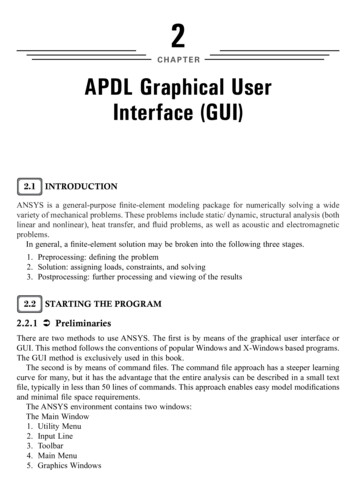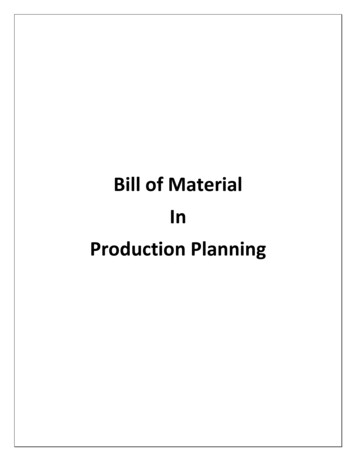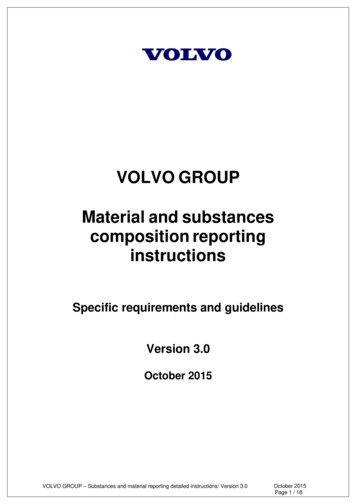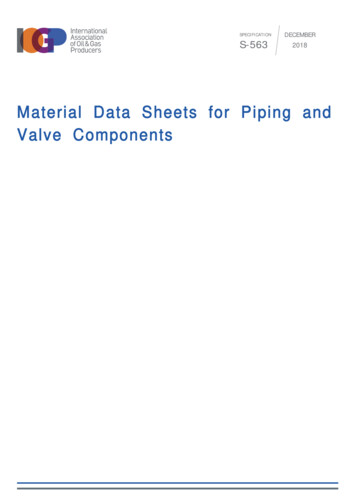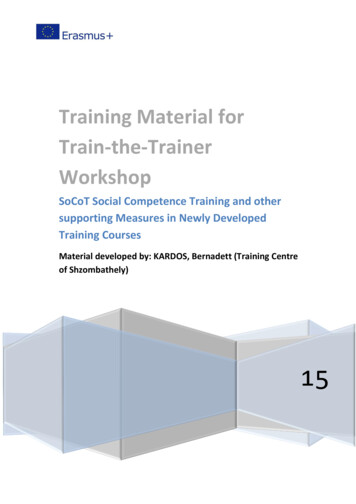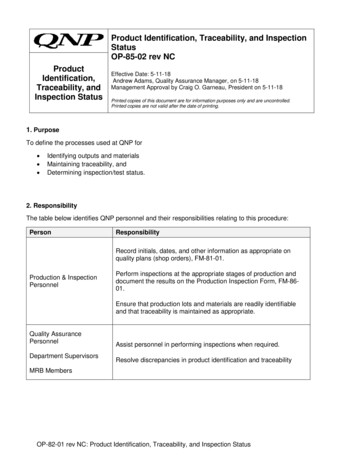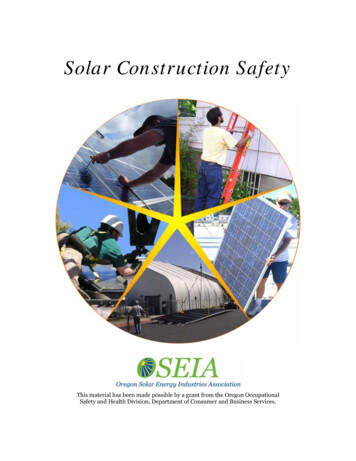
Transcription
Solar Construction SafetyThis material has been made possible by a grant from the Oregon OccupationalSafety and Health Division, Department of Consumer and Business Services.
ContentsIntroduction . 7Solar construction safety. 7How to use this manual. 8Employer information. 9Training your employees . 9Proactive safety policies .10General jobsite safety.12Evaluate and identify potential safety hazards and injuries .14Evaluate the specific work situation .14Understanding potential injuries from identified hazards.16General jobsite safe practices.17Develop a company personal protective equipment policy .18Develop procedures for using power tools and extension cords .19Develop hydration and safe practices while working in hot sun conditions.19Develop policies and procedures working with solar hot water collectors .19Develop policies and procedures for working with solar electric PV panels. 20Working smart. 20Recovering from accidents.21Preparing a safety-and-health policy .21Developing an emergency-response plan . 22When an emergency occurs. 23After an emergency. 23Where to find more information . 24Safety planning checklist . 24Review quiz: General jobsite safety . 25Lifting safety . 27Evaluate and identify lifting-related safety hazards. 29Evaluate your lifting-related hazards. 29Understanding potential lifting-related injuries . 30Procedures for lifting safely . 30Preventing back injuries.31Eliminating and controlling lifting-related hazards . 32Safe lifting procedures. 33Procedures for loading and unloading vehicles . 34Lifting and roof tops .35Working smart. 36Recovering from lifting-related accidents . 39What to do . 39Review quiz: Lifting safety . 40Ladder safety .41Evaluate and identify ladder safety hazards. 43Solar Construction Safety – 12/06iii
Evaluate your ladder hazards. 43Understanding potential injuries from ladder hazards . 44Procedures for working safely with ladders. 45Selecting the correct ladder for the job . 46Transporting and carrying ladders . 49Develop procedures to use ladders properly. 50Ladder inspection form.51Working smart. 58Recovering from ladder accidents . 60What to do . 60Review quiz: Ladder safety .61Fall protection and jobsite trip hazards. 63Evaluate and identify fall and trip safety hazards . 65Evaluate your fall and trip hazards . 65Understanding potential injuries from fall and trip hazards . 66Safety procedures for fall and trip hazard protection . 67Develop clean jobsite and work area practices . 68Fall protection policies and procedures . 68Fall-protection systems . 69Personal fall-protection systems .72Working Smart .75Recovering from fall and trip accidents.77Prompt rescue required.77Rescuing yourself after a fall . 78Review quiz: Fall protection and jobsite trip hazards . 79Solar plumbing safety . 81Evaluate and identify solar plumbing safety hazards. 83Evaluate solar plumbing hazards . 83Understanding potential injuries from solar plumbing hazards. 84Practices for working safely with solar plumbing. 84Safety procedures for typical plumbing torches . 85Soldering joints above shoulder level . 85Safety concerns with solar collectors . 86Working smart. 87Recovering from solar plumbing accidents . 88Review quiz: Solar plumbing safety. 89Solar electrical safety .91Evaluate and identify solar electrical safety hazards. 93General electrical hazards . 93Evaluate your electrical hazards. 95Understanding potential injuries from solar electric hazards. 95Practices for working safely with solar electric systems. 96Working with power tools and electric cords.97Working with electrical circuits .97Working with solar electric systems. 98Working with batteries . 100Working smart. 100Recovering from electrical accidents .101What to do . 101Review quiz: Solar electrical safety. 102ivContents
OSHA rules and general information . 103Oregon OSHA Services. 103Where to find more information .105Review quiz answers .107Index .111Solar Safety Manual FeedbackErrors, omissions, and general feedback on solar safety and this manual are welcome.If you see something that should be corrected, improved, or added please send an email withyour suggestions to: safety@oseia.org and include the Subject line: Safety Manual Feedback.Solar Construction Safety – 12/06v
IntroductionThis introduction to solar construction safety provides information to help develop safe workpractices for typical solar construction projects including both solar hot water and solar PVinstallations. In addition to this manual, attending ongoing OSHA and other safety coursescan build proficiency in safe work practices.This manual is intended to be useful to both employers and employees. Employers can use itto develop, deliver, and document training, and employees can use it as a basis for training.Oregon OSHA requires employees to be trained for the work they do. Completing this courseand the review sections at the end of each module tests employees’ understanding of thematerial and the results can be entered into the employees’ safety training records.Employees who work safely and efficiently are more valuable to their employers. This manualhelps employees learn the basics of construction safety. This is a good first step and it shouldbe followed up with appropriate safety and first aid courses, such as the free courses offeredby Oregon OSHA and other professionals.Oregon OSHA covers a broad range of safety requirements such as employer emergency plansand first aid kits. This manual points to additional OSHA information to help develop policiesto comply with some common OSHA requirements. To comply with Oregon OSHArequirements, business must follow all pertinent OSHA rules. Contact Oregon OSHA for moreinformation on courses, services, and requirements that pertain to your business. See theOSHA contact information at the end of this manual or check: www.orosha.org.Solar construction safetySolar construction safety, like general construction safety, requires more than knowledge ofsafety rules; it requires the ability to evaluate unique situations to actively create safe workpractices. This manual presents many common conditions found in typical solar work – bothelectrical and plumbing. These examples should be used as initial steps toward developingsafe work habits for employees and to assist employers in developing appropriate safetypolicies.Solar construction crews face many of the same conditions found in typical constructiontrades with notable exceptions that underscore the nature of both solar electric and solar hotwater equipment: exposure to sunlight creates stored energy not present in otherconstruction trades. Managing this energy safely is an important aspect of solar construction.This manual prescribes the following process to minimize workplace hazards:1. Evaluate and identify hazards.2. Eliminate or remove hazards.3. Control hazards that cannot be eliminated.4. Recover from accidentsSolar Construction Safety – 12/067
How to use this manualThis material is for training purposes only. Its purpose is to inform Oregon employers andemployees of best practices in occupational safety and health and general Oregon OSHAcompliance requirements. This material is not a substitute for any provision of the OregonSafe Employment Act or any standards issued by Oregon OSHA.Safety is the responsibility of both the employer and the employee. The employer isresponsible for ensuring that employees are properly trained and equipped and that theyfollow the standard safety practices established by the business. The employee is responsiblefor following safety practices that protect themselves and fellow workers.This manual provides useful information for both employers and employees: Employees can review each safety module and assess their knowledge by completing thereview quizzes at the end of each module. Employers can use this manual to organize training for employees. Employers can use this manual to help document training by assuring that each employeewho completes a module also signs and dates the review quiz page. The employer thenretains the signed and dated review quiz in the employee’s records. For review quizanswers, please see Review quiz answers on page 107. Employers are encouraged to use or modify the review sheets at the end of each moduleto fit their specific situations.The safety topics in this manual are presented in task-oriented modules (chapters) associatedwith the solar industry. Modules can be used independently or grouped together in any wayand are not necessarily meant to be used in the order they are presented here. The safetytraining needs of each individual should determine which modules are completed.Each module includes four main sections that cover specific areas associated with developinga proactive safety policy. Each section has a goal and associated symbol as described below.Notice how each section contributes to an overall understanding of safe work practices.Section 1: Evaluate and identify potential safety hazards andinjuriesKnowing how to identify potential safety hazards is critical tounderstanding potential injuries, preventing accidents, and recoveringfrom accidents.Section 2: Prevent accidents by using safe work practicesKnowing how to work in a safe manner is critical to preventing andrecovering from accidents.Section 3: Recover from accidents using preplanningYou must be prepared to recover from accidents if they occur. When anaccident occurs, it’s difficult to think clearly – this is the wrong time tostart planning how to recover from the situation.Section 4: Section review quiz with questionsThe section review checks employees’ understanding of the material andcan be entered into the employee’s safety training record to comply withOregon OSHA training requirements. Review quiz answers are located atthe end of the manual.8Introduction
Oregon OSHA InformationOregon OSHA information appearsin this box.Safety Tip: Safety tips appearin this box.Employer informationSuccessful safety programs have safety policies that are followed. Failure to have policiesaffects a company’s bottom line. Safety policies are ineffective unless they are enforced andreviewed consistently.This section explains how employers can use this manual to train employees as a part of theireffort to comply with OSHA requirements. To review all of the requirements for a specificbusiness, contact Oregon OSHA or check requirements at: www.orosha.org.Oregon OSHA InformationOregon OSHA provides Consultation Services to help employers.Oregon OSHA offers a service that has helped thousands of Oregon employers createsafer workplaces and reduce their workers’ compensation costs by as much as 60percent.Free work site safety, health, and ergonomic consultations, by a trained professional,are available to Oregon employers. Oregon OSHA safety and health professionalsacross the state provide free consultations at more than 2,000 work sites each year inOregon. Consultations, conducted at the request of an employer, evaluate any or allaspects of work site occupational safety and health. The employer determines thescope of the evaluation.Employers receiving a consultation are provided a report summarizing the visit,including recommendations for improvement. Consultations are kept confidentialfrom Oregon OSHA’s enforcement program. Check the web at:www.orosha.org/consultation.html for more information.Training your employeesOregon employers are required to properly train and supervise workers in the safe operationof any machinery, tools, equipment, processes, or practices which they are authorized to useor apply. Employers are also required to document training (see OAR 437-001-0760 for moreinformation).Providing sufficient training takes time and effort but it pays off quickly. Avoiding delays andcostly accidents are immediate benefits.Solar Construction Safety – 12/069
There are several ways to train employees: Perform the training within the business. Send employees to professional training courses such as free classroom training offeredby OSHA or first aid training offered by the Red Cross. Add to training by requiring that employees complete manuals such as this one.A combination of training that includes study and both in-house and external courses isrecommended to provide a more robust safety policy at your workplace.When providing safety training in-house, use these guidelines to help employees internalizesafety into everyday work habits: Conduct training in a non-threatening and controlled environment. For example, don’ttake a new employee up to a roof top to learn roof safety. Conduct training in a safe environment where employees are encouraged to ask questionsand they can make mistakes without hurting themselves. Assure that in-house training is provided by a competent person as defined by OSHA.Oregon OSHA InformationEmployers must ensure that employees are trained by a competent person to recognize hazardsand instruct them to minimize these hazards.A competent person means one who is capable of identifying existing and predictable hazardsin the surroundings or working conditions which are unsanitary, hazardous, or dangerous toemployees, and who has authorization to take prompt corrective measures to eliminate them.A qualified person means one who, by possession of a recognized degree, certificate, orprofessional standing, or who by extensive knowledge, training, and experience, hassuccessfully demonstrated the ability to solve or resolve problems relating to the subjectmatter, the work, or the project.Proactive safety policies*The following information is excerpted from Oregon OSHA online course 100. Allemployers are encouraged to take this online course to learn more about setting up safetypolicies for business.According to the OSEAct, every employer has a legal obligation to provide and maintain a safeand healthful workplace for employees.Taking risks is part of running a business. You take risks in product development, marketing,and advertising in order to stay competitive. But there are some risks that should never betaken. One of these risks is the safety and health of the employees in the company.A proactive strategy means taking action to make sure accidents do not happen in theworkplace. A proactive response to safety and health in the workplace must occur before anaccident can be prevented.The proactive improvement process first identifies a hazard and anticipates the possibleinjury. The hazard is analyzed, recommendations proposed, and corrective actions andsystem improvements are implemented. The proactive improvement process predicts in10Introduction
order to prevent. Proactive strategies look forward. By emphasizing accident prevention,management sends a message of caring to all employees. The safety professional attempts toidentify and analyze hazardous conditions and unsafe behaviors in order to predict futureaccidents. Proactive strategies are always less expensive than reactive strategies. Remember,proactive programs are implemented to prevent future injuries and illnesses.Consider some of the costs associated with accidents and you will quickly find that having aproactive safety policy in place is a smart investment and better for everyone involved. Hereare some potential costs associated with accidents:Consider what one lost workday injury might cost your company in terms of: Production down-time. Productive time lost by an injured employee. Productive time lost by employees and supervisors helping the accident victim. Cleanup and start-up of operations interrupted by an accident. Time to hire or train a worker to replace the injured worker until they return to work. Time and cost for repair or replacement of damaged equipment or materials. Cost of continuing all or part of the employee’s wages, plus compensation. Reduced morale among your employees and perhaps lower efficiency. Cost of completing paperwork generated by the accident. OSHA penalties.According to the National Safety Council, which considers all industries nationally, in 2000the average direct and indirect cost of a lost time injury was over 28,000, and a fatalityaveraged 980,000. In Oregon, the direct costs to close a disabling injury claim is around 10,000 and it will cost an average of 300,000 to close a fatality claim.Additional safety planning informationA good reference guide for developing sound safety practices for your workplace is availableat Oregon OSHA: A Foundation for a Safe Workplace; Oregon OSHA. This manual presentsan overview of setting up the foundation for safety policies at your workplace and providessample checklists and forms that you can use for your business. The manual is available forfree at the website managepubs.htmlSolar Construction Safety – 12/0611
Module 1:General jobsite safetyThis general jobsite safety module presents the starting point for on-the-job safety –developing a proactive approach to safety.This module introduces the proactive approach that continues throughout this solarconstruction safety manual. The underlying premise of proactive jobsite safety is that it isALWAYS safer and less expensive to eliminate and prevent safety hazards.Module ContentsEvaluate and identify potential safety hazards and injuries .14Evaluate the specific work situation .14Understanding potential injuries from identified hazards.16General jobsite safe practices.17Develop a company personal protective equipment policy .18Develop procedures for using power tools and extension cords .19Develop hydration and safe practices while working in hot sun conditions.19Develop policies and procedures working with solar hot water collectors .19Develop policies and procedures for working with solar electric PV panels. 20Working smart. 20Recovering from accidents.21Preparing a safety-and-health policy .21Developing an emergency-response plan . 22When an emergency occurs. 23After an emergency. 23Where to find more information . 24Safety planning checklist . 24Review quiz: General jobsite safety . 25Solar Construction Safety – 12/0612
Learning objectivesThe general jobsite safety module provides: Basic attributes of a proactive safety program. How to create a proactive safety policy in your workplace. General jobsite safety regarding: Personal protective equipment (PPE). Developing a safety plan. Recovering from jobsite accidents.Safety is an integral part of work done in the solar industry. Working safely is as important asthe skills and techniques used with typical construction tools. More valuable employeesconsider good safety practices to be a skill.Safe installations are more efficient and cost effective. Using equipment properly and workingsafely results in less time lost to injuries and the delays they cause, and can prevent finesbeing assessed from agencies responsible for enforcing workplace regulations.A proactive approach is the first step on the road to developing safety policies that could saveyour life or the life of a co-worker.Safety Tip: Use the following process to minimize workplace hazards:1.Evaluate and identify hazards.2.Eliminate or remove hazards.3.Control hazards that cannot be eliminated.4.Plan for your recovery from accidents.Solar Construction Safety – 12/0613
Evaluate and identify potential safety hazards and injuriesLearning to evaluate and identify potential safety hazards is a critical first step to eliminatingrisks and potential injuries. A good understanding of workplace hazards enables you toprevent accidents and recover more quickly if one occurs.Each workplace presents its own unique set of occupational hazards. Conducting an analysisof your unique hazards: Leads to properly identifying safety training needs. Helps identify the measures necessary to ensure the workplace is a safe one, such as theneed for additional equipment and personal protective gear. Helps determine how to eliminate or control hazards before they cause injuries.To take the first step in identifying hazards, learn the specifics about the work you are goingto do, along with when and where it takes place. Following are some examples of questions toconsider when evaluating each job and jobsite: Are employees trained to perform the job with which they are tasked? Are safety policies and procedures in place and enforced? Are employees trained on company safety policies and procedures? Are you the general contractor or a subcontractor at the jobsite? What safetyresponsibilities are assigned to each? Is required personal protective equipment available and in good condition? What prep-work is required prior to the job? What are the general jobsite tasks and conditions? Are employees working from ladders or roof tops? Is fall protection required? What tools are being used to complete the job? Are severe conditions such as wet, windy, high heat, or cold weather involved? What post-job cleanup and work is required?Evaluate the specific work situationIt’s important to evaluate each specific situation to develop a list of the hazards and thepotential injuries that could occur. Understanding the hazards and potential injuries, and thelikelihood of an accident occurring, enables you to set up a suitable safety policy for eachspecific situation.Use the questions included in the previous section and deve
installations. In addition to this manual, attending ongoing OSHA and other safety courses can build proficiency in safe work practices. This manual is intended to be useful to both employers and employees. Employers can use it to develop, deliver, and document training, and emplo

